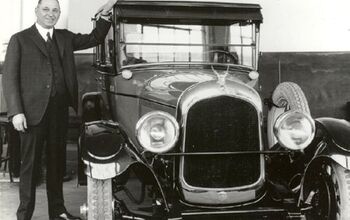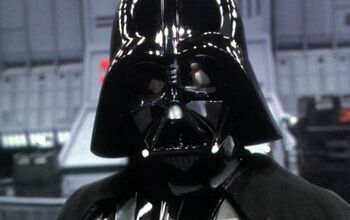Chrysler Suicide Watch 50: RIP

Chrysler’s logo should have been a bottle of lithium, rather than the Pentastar. It suffered from severe bipolar disorder all its life, and, sadly, died from it at its own hands. Like many suicidal bipolars (e.g., Van Gogh, Hemingway, Virgina Woolf), Chrysler’s many crashes and acts of self-mutilation were punctuated by fantastic highs of brilliant engineering, design and creativity. Chrysler has taken us on quite the roller coaster ride. And now it’s over. As we stumble out of our (Hemi-powered) coaster car, we’re left with an intense mixture of relief, thrill, and sadness.
Chrysler’s beginning was an unparalleled flash of genius and overnight success. Walter P. Chrysler had a fairy-tale career in the early automobile business, earning $10 million ($130 million today) in just three years while turning Buick into GM’s early powerhouse. Then, while running Maxwell, he launched the Chrysler line in 1924 with that just-perfect blend of advanced engineering and style.
It was a home run that catapulted Chrysler to number four out of a crowded field of 49 manufacturers. The subsequent successful launches of the low-price Plymouth, the upper-mid priced DeSoto, and the purchase of mid-priced Dodge firmly established Chrysler as a charter member of the Big Three.
Chrysler’s first crisis came in 1934 with the failure of the radically advanced but unusual-looking Airflow. Its wholesale rejection by the buying public taught Chrysler (and Detroit) a painful lesson: avoid extreme innovation.
Chrysler recuperated and made enormous profits during the WWII era. But the development of the all-new 1949 models was haunted by Chrysler’s still-lingering Airflow insecurities. Whereas GM and Ford confidently introduced longer and lower models designed to thrill exuberant post-was buyers, Chrysler president P. T. Keller insisted on tall, boxy cars.
In the early fifties, Americans were in the mood for more—horsepower, automatics, power steering and brakes, style, and flash. Unlike Chevy and Ford, Plymouth offered none of those, and the market punished it unmercifully. In 1954, Plymouth was kicked out of its long-established number three spot by Buick and dropped to number five behind Pontiac.
The exuberant designer Virgil Exner was hired to inject vitality and fresh style. The 1955s were an improvement, but the radical 1957s were destined to be the great leap forward (“suddenly it’s 1960!”). But in the rush to revolutionize, the products were not fully developed, and suffered from atrocious build quality.
The flashy ’57s sold, but word got out and buyers punished Chrysler unmercifully. 1958 sales plunged by no less than 41% for Plymouth. And despite a reputation for engineering excellence, Chrysler would have to dodge a reputation for spotty build quality from then on, deserved or not.
Chrysler nursed itself to health once more, only to be deeply wounded by one of the most staggeringly idiotic acts of executive self-mutilation. In 1960, Chrysler president William Newberg overheard a rumor at a cocktail party that Chevrolet was working on a dramatically smaller 1962 model (it was: the compact Chevy II).
In a colossal blunder, he assumed this referred to the full-sized Chevrolets. Newberg killed development of the full size 1962 Plymouths and Dodges and initiated a crash program for substantially downsized replacements. When the ugly, truncated ’62s were first shown to dealers, an uproar ensued, and twenty dealers cancelled their franchises on the spot. Plymouth crashed to ninth place, while GM’s market share rose to an all-time peak of 52%.
Chrysler barely survived the fiasco but went on to enjoy a relatively long spell of good health from the mid-60s through 1974, in part thanks to its successful performance image. But with a portfolio of heavy RWD cars and lacking the foresight, will (and capital) to retool extensively, Chrysler was flattened by the one-two punch of the energy crises. By 1979, it was back on the critical list, saved from bankruptcy only by the life-support of a government loan-guarantee act.
This financed the compact K-car; Chrysler squeaked by and regained health, once again. Endless K-car variants carried the day. When the 1990 recession brought on another depression, Iaccoca was shown the door.
In the mid-nineties, Chrysler was on its ultimate manic high. Low overhead costs from its near-bankruptcy, some deft model development, the purchase of Jeep, and sheer luck (the boom of the truck and SUV markets) generated huge profits and a 23% market share in 1997 (bigger than GM’s recently). But at the very height of health and success, the suicidal urges return.
In 1998, CEO Robert Eaton had Chrysler engage in ritual corporate seppuku by selling itself to Daimler (while walking away with over $200 million himself). And despite all of Dr. Z’s ministrations, the patient never really regained lasting health. Was there arsenic in the Daimler medicine?
There’s a market for corpses, and Cerberus bit with all three heads at once. And choked.

More by Paul Niedermeyer
Latest Car Reviews
Read moreLatest Product Reviews
Read moreRecent Comments
- Dave Holzman My '08 Civic (stick, 159k on the clock) is my favorite car that I've ever owned. If I had to choose between the current Civic and Corolla, I'd test drive 'em (with stick), and see how they felt. But I'd be approaching this choice partial to the Civic. I would not want any sort of automatic transmission, or the turbo engine.
- Merc190 I would say Civic Si all the way if it still revved to 8300 rpm with no turbo. But nowadays I would pick the Corolla because I think they have a more clear idea on their respective models identity and mission. I also believe Toyota has a higher standard for quality.
- Dave Holzman I think we're mixing up a few things here. I won't swear to it, but I'd be damned surprised if they were putting fire retardant in the seats of any cars from the '50s, or even the '60s. I can't quite conjure up the new car smell of the '57 Chevy my parents bought on October 17th of that year... but I could do so--vividly--until the last five years or so. I loved that scent, and when I smelled it, I could see the snow on Hollis Street in Cambridge Mass, as one or the other parent got ready to drive me to nursery school, and I could remember staring up at the sky on Christmas Eve, 1957, wondering if I might see Santa Claus flying overhead in his sleigh. No, I don't think the fire retardant on the foam in the seats of 21st (and maybe late 20th) century cars has anything to do with new car smell. (That doesn't mean new car small lacked toxicity--it probably had some.)
- ToolGuy Is this a website or a podcast with homework? You want me to answer the QOTD before I listen to the podcast? Last time I worked on one of our vehicles (2010 RAV4 2.5L L4) was this past week -- replaced the right front passenger window regulator (only problem turned out to be two loose screws, but went ahead and installed the new part), replaced a bulb in the dash, finally ordered new upper dash finishers (non-OEM) because I cracked one of them ~2 years ago.Looked at the mileage (157K) and scratched my head and proactively ordered plugs, coils, PCV valve, air filter and a spare oil filter, plus a new oil filter housing (for the weirdo cartridge-type filter). Those might go in tomorrow. Is this interesting to you? It ain't that interesting to me. 😉The more intriguing part to me, is I have noticed some 'blowby' (but is it) when the oil filler cap is removed which I don't think was there before. But of course I'm old and forgetful. Is it worth doing a compression test? Leakdown test? Perhaps if a guy were already replacing the plugs...
- Crown No surprise there. The toxic chemical stew of outgassing.


































Comments
Join the conversation
One of the primary things that had kept Chrysler afloat through all the mistakes for so many years was the military division. Ever since WWII, Chrysler management could screw up as badly as they wanted so long as the military division cash-cow continued to churn out tanks for the US military. But then came the seventies' crisis and Iacocca. Lido has said in his first book that one of the most difficult decisions he had to make to keep Chrysler going was whether to continue building cars or military vehicles. Ultimately, it was the military division that went. It was the right decision for the time but, in the long run, not having the military division for the company to fall back on through the rough periods (as it had so many times in the past) would ultimately spell its doom.